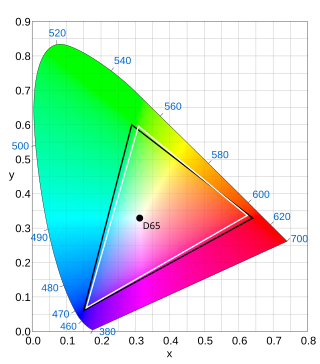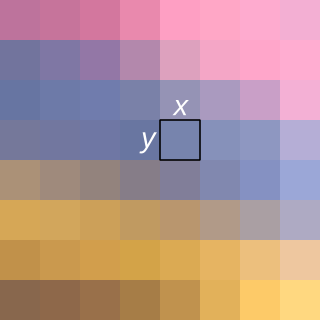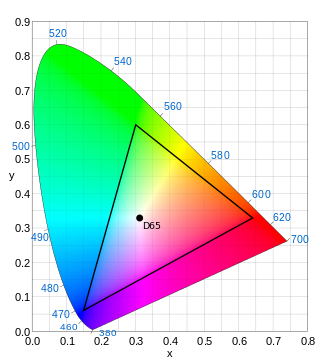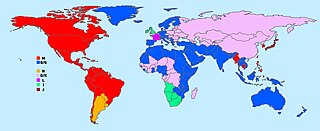
Phase Alternating Line (PAL) is a colour encoding system for analog television. It was one of three major analogue colour television standards, the others being NTSC and SECAM. In most countries it was broadcast at 625 lines, 50 fields per second, and associated with CCIR analogue broadcast television systems B, D, G, H, I or K. The articles on analog broadcast television systems further describe frame rates, image resolution, and audio modulation.

Standard-definition television is a television system that uses a resolution that is not considered to be either high or enhanced definition. Standard refers to offering a similar resolution to the analog broadcast systems used when it was introduced.

SECAM, also written SÉCAM, is an analog color television system that was used in France, Russia and some other countries or territories of Europe and Africa. It was one of three major analog color television standards, the others being PAL and NTSC. Like PAL, a SECAM picture is also made up of 625 interlaced lines and is displayed at a rate of 25 frames per second. However, due to the way SECAM processes color information, it is not compatible with the PAL video format standard. SECAM video is composite video because the luminance and chrominance are transmitted together as one signal.

ITU-R Recommendation BT.601, more commonly known by the abbreviations Rec. 601 or BT.601, is a standard originally issued in 1982 by the CCIR for encoding interlaced analog video signals in digital video form. It includes methods of encoding 525-line 60 Hz and 625-line 50 Hz signals, both with an active region covering 720 luminance samples and 360 chrominance samples per line. The color encoding system is known as YCbCr 4:2:2.
Broadcasttelevision systems are the encoding or formatting systems for the transmission and reception of terrestrial television signals.
Enhanced-definition television, or extended-definition television (EDTV) is a Consumer Electronics Association (CEA) marketing shorthand term for certain digital television (DTV) formats and devices. Specifically, this term defines an extension of the standard-definition television (SDTV) format that enables a clearer picture during high-motion scenes compared to previous iterations of SDTV, but not producing images as detailed as high-definition television (HDTV).

16:9 is a widescreen aspect ratio with a width of 16 units and height of 9 units.
PALplus is an analogue television broadcasting system aimed to improve and enhance the PAL format by allowing 16:9 aspect ratio broadcasts, while remaining compatible with existing television receivers, defined by International Telecommunication Union (ITU) recommendation BT.1197-1. Introduced in 1993, it followed experiences with the HD-MAC and D2-MAC, hybrid analogue-digital widescreen formats that were incompatible with PAL receivers. It was developed at the University of Dortmund in Germany, in cooperation with German terrestrial broadcasters and European and Japanese manufacturers. The system had some adoption across Europe during the late 1990s and helped introduce widescreen TVs in the market, but never became mainstream.

480i is the video mode used for standard-definition digital video in the Caribbean, Japan, South Korea, Taiwan, Philippines, Myanmar, Western Sahara, and most of the Americas. The other common standard definition digital standard, used in the rest of the world, is 576i.
576p is the shorthand name for a video display resolution. The p stands for progressive scan, i.e. non-interlaced, the 576 for a vertical resolution of 576 pixels. Usually it corresponds to a digital video mode with a 4:3 anamorphic resolution of 720x576 and a frame rate of 25 frames per second (576p25), and thus using the same bandwidth and carrying the same amount of pixel data as 576i, but other resolutions and frame rates are possible.
Overscan is a behaviour in certain television sets in which part of the input picture is cut off by the visible bounds of the screen. It exists because cathode-ray tube (CRT) television sets from the 1930s to the early 2000s were highly variable in how the video image was positioned within the borders of the screen. It then became common practice to have video signals with black edges around the picture, which the television was meant to discard in this way.

Dot crawl is a visual defect of color analog video standards when signals are transmitted as composite video, as in terrestrial broadcast television. It consists of moving checkerboard patterns which appear along horizontal color transitions. It results from intermodulation or crosstalk between chrominance and luminance components of the signal, which are imperfectly multiplexed in the frequency domain.

Multiplexed Analogue Components (MAC) was an analog television standard where luminance and chrominance components were transmitted separately. This was an evolution from older color TV systems where there was interference between chrominance and luminance.
In television technology, Active Format Description (AFD) is a standard set of codes that can be sent in the MPEG video stream or in the baseband SDI video signal that carries information about their aspect ratio and other active picture characteristics. It has been used by television broadcasters to enable both 4:3 and 16:9 television sets to optimally present pictures transmitted in either format. It has also been used by broadcasters to dynamically control how down-conversion equipment formats widescreen 16:9 pictures for 4:3 displays.

A Pixel aspect ratio is a mathematical ratio that describes how the width of a pixel in a digital image compared to the height of that pixel.

PAL-M is the analogue colour TV system used in Brazil since early 1972, making it the first South American country to broadcast in colour.

B-MAC is a form of analog video encoding, specifically a type of Multiplexed Analogue Components (MAC) encoding. MAC encoding was designed in the mid 80s for use with Direct Broadcast Satellite systems. Other analog video encoding systems include NTSC, PAL and SECAM. Unlike the FDM method used in those, MAC encoding uses a TDM method. B-MAC was a proprietary MAC encoding used by Scientific-Atlanta for encrypting broadcast video services; the full name was "Multiple Analogue Component, Type B".

Rec. 709, also known as Rec.709, BT.709, and ITU 709, is a standard developed by ITU-R for image encoding and signal characteristics of high-definition television.

CCIR System M, sometimes called 525–line, NTSC, NTSC-M, or CCIR-M, is the analog broadcast television system approved by the FCC for use in the United States since July 1, 1941, replacing the 441-line TV system introduced in 1938. It is also known as EIA standard 170. System M comprises a total of 525 interlaced lines of video, of which 486 contain the image information, at 30 frames per second. Video is amplitude modulated and audio is frequency modulated, with a total bandwidth of 6 MHz for each channel, including a guard band.
Clear-Vision is a Japanese EDTV television system introduced in the 1990s, that improves audio and video quality while remaining compatible with the existing broadcast standard. Developed to improve analog NTSC, it adds features like progressive scan, ghost cancellation and widescreen image format. A similar system named PALPlus was develop in Europe with the goal of improving analog PAL broadcasts.
















